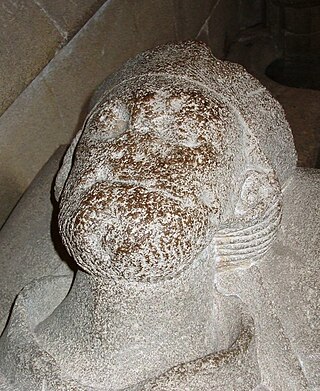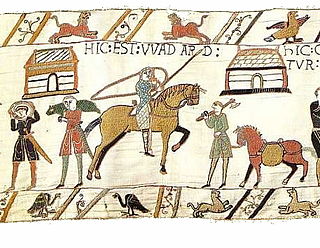Background
The abbey, founded in 598, was given various incremental endowments. King Edward the Confessor in 1055 gave two of the three parts of Fordwich Borough to the Abbey, the third part was confiscated by the sheriff but given to the Abbey (whether before or as a result of this action) having belonged to Earl Godwin of Wessex (who was Edward's wife's father). [4]
The last abbott (Egelsin), very much a Saxon, fled from office in 1070 in some way seen to have joined, or having joined, Archbishop Stigand's resistance to William. [4] Before doing so to gain the favour of the powerful Normans, he granted one, Hamo (also recorded as Hamo de Crevequer, surnamed Vicecomes), several estates, among which Fordwich borough. [2] The King endorsed the confiscation of the land on his flight and replaced him with the Norman or pro-Norman, Scotland. [5] Scotland proved an astute abbot.

William I, usually known as William the Conqueror and sometimes William the Bastard, was the first Norman king of England, reigning from 1066 until his death in 1087. A descendant of Rollo, he was Duke of Normandy from 1035 onward. By 1060, following a long struggle to establish his throne, his hold on Normandy was secure. In 1066, following the death of Edward the Confessor, William invaded England, leading an army of Normans to victory over the Anglo-Saxon forces of Harold Godwinson at the Battle of Hastings, and suppressed subsequent English revolts in what has become known as the Norman Conquest. The rest of his life was marked by struggles to consolidate his hold over England and his continental lands, and by difficulties with his eldest son, Robert Curthose.

The Bayeux Tapestry is an embroidered cloth nearly 70 metres long and 50 centimetres tall that depicts the events leading up to the Norman Conquest of England in 1066, led by William, Duke of Normandy challenging Harold II, King of England, and culminating in the Battle of Hastings. It is thought to date to the 11th century, within a few years after the battle. It tells the story from the point of view of the conquering Normans but is now widely accepted to have been made in England.

Plumstead is an area in southeast London, within the Royal Borough of Greenwich, England. It is located east of Woolwich.

William de St-Calais was a medieval Norman monk, abbot of the abbey of Saint-Vincent in Le Mans in Maine, who was nominated by King William I of England as Bishop of Durham in 1080. During his term as bishop, St-Calais replaced the canons of his cathedral chapter with monks, and began the construction of Durham Cathedral. In addition to his ecclesiastical duties, he served as a commissioner for the Domesday Book of 1086. He was also a councillor and advisor to both King William I and his son, King William II, known as William Rufus. Following William Rufus' accession to the throne in 1087, St-Calais is considered by scholars to have been the new king's chief advisor.

Thomas of Bayeux was Archbishop of York from 1070 until 1100. He was educated at Liège and became a royal chaplain to Duke William of Normandy, who later became King William I of England. After the Norman Conquest, the king nominated Thomas to succeed Ealdred as Archbishop of York. After Thomas' election, Lanfranc, Archbishop of Canterbury, demanded an oath from Thomas to obey him and any future Archbishops of Canterbury; this was part of Lanfranc's claim that Canterbury was the primary bishopric, and its holder the head of the English Church. Thomas countered that York had never made such an oath. As a result, Lanfranc refused to consecrate him. The King eventually persuaded Thomas to submit, but Thomas and Lanfranc continued to clash over ecclesiastical issues, including the primacy of Canterbury, which dioceses belonged to the province of York, and the question of how York's obedience to Canterbury would be expressed.

Gisa was Bishop of Wells from 1060 to 1088. A native of Lorraine, Gisa came to England as a chaplain to King Edward the Confessor. After his appointment to Wells, he travelled to Rome rather than be consecrated by Stigand, the Archbishop of Canterbury. As bishop, Gisa added buildings to his cathedral, introduced new saints to his diocese, and instituted the office of archdeacon in his diocese. After the Norman Conquest, Gisa took part in the consecration of Lanfranc, the new Archbishop of Canterbury, and attended Lanfranc's church councils. His tomb in Wells Cathedral was opened in the 20th century and a cross was discovered in his tomb.
Æthelric was the second to last medieval Bishop of Selsey in England before the see was moved to Chichester. Consecrated a bishop in 1058, he was deposed in 1070 for unknown reasons and then imprisoned by King William I of England. He was considered one of the best legal experts of his time, and was even brought from his prison to attend the trial on Penenden Heath where he gave testimony about English law before the Norman Conquest of England.

The Accord of Winchester is the 11th-century document that establishes the primacy of the archbishop of Canterbury over the archbishop of York.

William the Conqueror had men of diverse standing and origins under his command at the Battle of Hastings in 1066. With these and other men he went on in the five succeeding years to conduct the Harrying of the North and complete the Norman conquest of England.

Penenden Heath is a suburb in the town of Maidstone in Kent, England. As the name suggests it is nucleated around a former heath.
The trial of Penenden Heath occurred in the decade after the Norman Conquest of England in 1066, probably in 1076, and involved a dispute between Odo, Bishop of Bayeux, half-brother of William the Conqueror and Lanfranc, Archbishop of Canterbury and others.
Events from the 1080s in England.
Events from the 1070s in England.
Urse d'Abetot was a Norman who followed King William I to England, and became Sheriff of Worcestershire and a royal official under him and Kings William II and Henry I. He was a native of Normandy and moved to England shortly after the Norman Conquest of England in 1066, and was appointed sheriff in about 1069. Little is known of his family in Normandy, who were not prominent, but he probably got his name from the village Abetot. Although Urse's lord in Normandy was present at the Battle of Hastings, there is no evidence that Urse took part in the invasion of England in 1066.
Hamo Dapifer was an Anglo-Norman royal official under both King William I of England and his son King William II of England. He held the office, from which his epithet derives, known in Latin as dapifer and in French seneschal, in English "steward", as well as the office of Sheriff of Kent.
Walter, Abbot of Evesham or Walter de Cerisy, Gauthier de Cerisy was an 11th-century abbot and church leader in England under the Norman conquest. He is known from the Domesday Book and several legal documents.
Hamo the Steward, the Sheriff of Kent was a leading person during the 11th century, Norman Conquest of England.
Scolland of Canterbury also known as Scotland was the abbot of St Augustine's Abbey during the Norman conquest of England.

Wadard was an 11th-century Norman nobleman who is mentioned in the Domesday Book of 1086, and is depicted in the Bayeux Tapestry.









